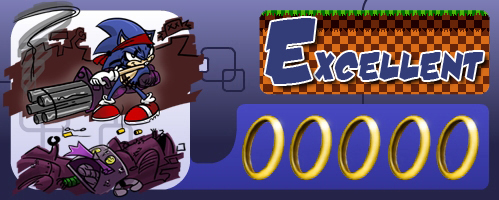VERDICT
EXCELLENT
EXCELLENT
Within the constraints of the hardware (read: no 3D), this is just about as good as it gets, and this piece of SEGA history is one any fan should be proud to have on their Switch.
Space Harrier is something of an unsung legend of SEGA nowadays.
If you were into video games back in the mid- to late-80’s, it was all but impossible not to have at least heard of Space Harrier. Even if you were a dyed-in-the-wool Nintendo fan, it was one of those games which simply commanded attention on account of how unique it was. You not only had Yu Suzuki’s trademark Super Scaler technology providing stunning 3D pixel art visuals, but the very concept and art design was something you would not soon forget.
Cycloptic mammoths? Where else are you going to see that?
It was the kind of thing that helped set SEGA apart from everyone else.
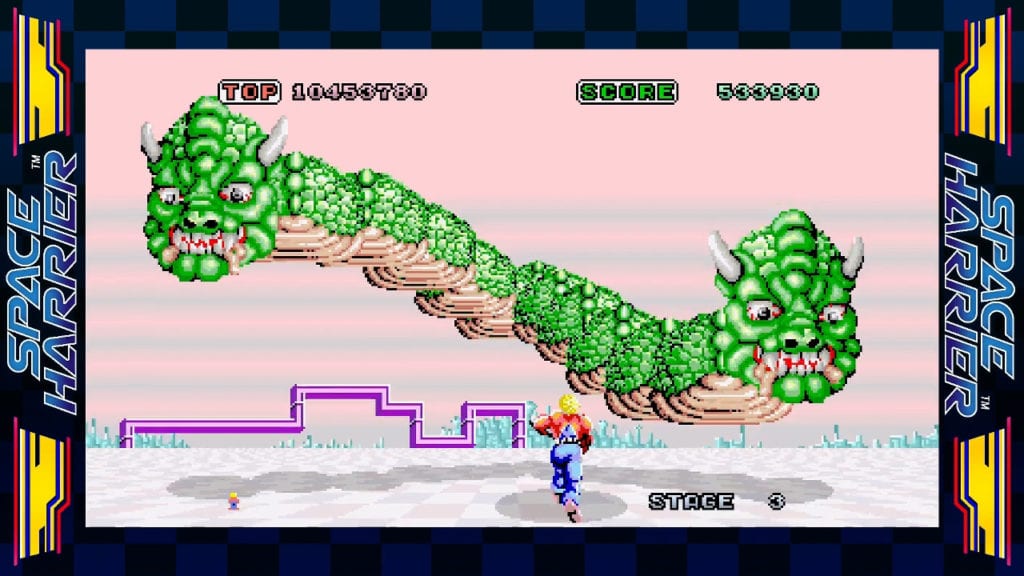
Welcome to the Premise Zone!
The very premise is so unique as well. You play as a character called the Harrier, who is flying and blasting his way through a world known as the Fantasy Zone (not to be confused with the game Fantasy Zone, though there was almost a crossover between the two). However, his means of traversal isn’t a jetpack or rocket boots or anything like that — he flies thanks to the oversized gun he carries under one arm.
There seems to be something of a story to it all — well, as much as anything had a story back then, I suppose — but the little blurbs that come up to move what passes for a narrative along hit as hard and fast as the action you’ll face in the game. Coin-op games are alternately known as “quarter-munchers,” and for good reason: Many an arcade game was designed with the express purpose of separating you from your coinage as quickly as possible, and Space Harrier is an exemplary demonstration of this game design mindset in action.
Early on, it’s not so bad. The action moves at a swift pace, and while challenging, is easy enough to keep up with. By the time you reach Level 18 (the final level), however, you’ll be dying before you even know what hit you, running through lives and constantly being prompted to insert another coin.
In truth, I’m not even sure it’s possible to beat the game without spamming the coin slot repeatedly. If you had enough money, then sure, you could see the ending, but odds are that it was less earned than it was bought — you only “earned” it by spending enough money to reach the end.
At least, that’s how it feels in this port. Even if you crank the difficulty down to 1 and the number of lives per credit up to 5, you’ll still be pummeled. Fortunately, instead of dropping quarters, all you have to do on the Switch is press Up and X twice (one to “deposit” a coin, again to continue on) to proceed on your journey of destruction. Keep doing that, and you’ll see the end.
Or, I suppose you could develop a mutation which grants you speed and reflexes which could only be described as “stunning” to see in action. Either way, it’s a pretty enjoyable ride from beginning to end.
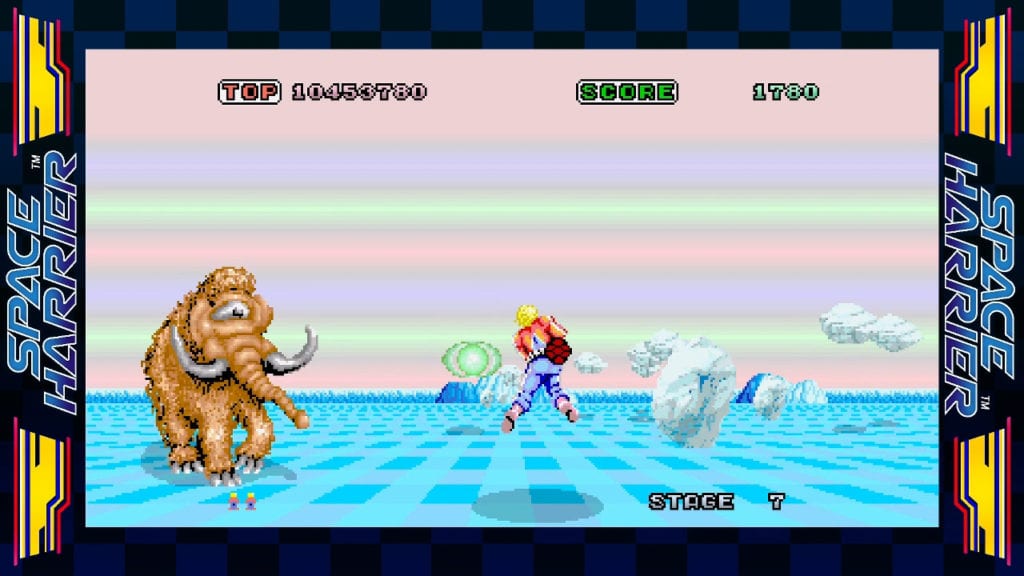
Welcome to the Feature Zone!
In addition to paving your road to victory with virtual currency, the SEGA Ages version of Space Harrier contains a host of other options and features for you to play with and tweak to your preferences, such as how many points you’ll need to “extend,” or turn Trial Time on or off. You can save your game and load it from where you left off, or just use the stage select to go to whichever stage you please, if it suits you.
You can also adjust the sound levels for the background music, sound effects, and separately from that, the gunshots. Or just play the game’s soundtrack in the music player.
In terms of control features, you can toggle the rapidfire setting between three different speeds, invert the flight controls (the default is the inverted flight stick-styled “up is down and down is up” style, which I usually prefer, but for this, I found up being up to work better for me), and pick between two control schemes. You can also adjust Harrier’s “moving area” between three different options, and turn the Switch’s trademark HD Rumble on or off.
Display options are the usual suite you’d expect from M2, including widescreen, arcade widescreen, normal, and others. Likewise, you can adjust wallpapers in accordance with the display mode, including an arcade cabinet background, and adjust filters for scanlines, smoothing, both, or neither.
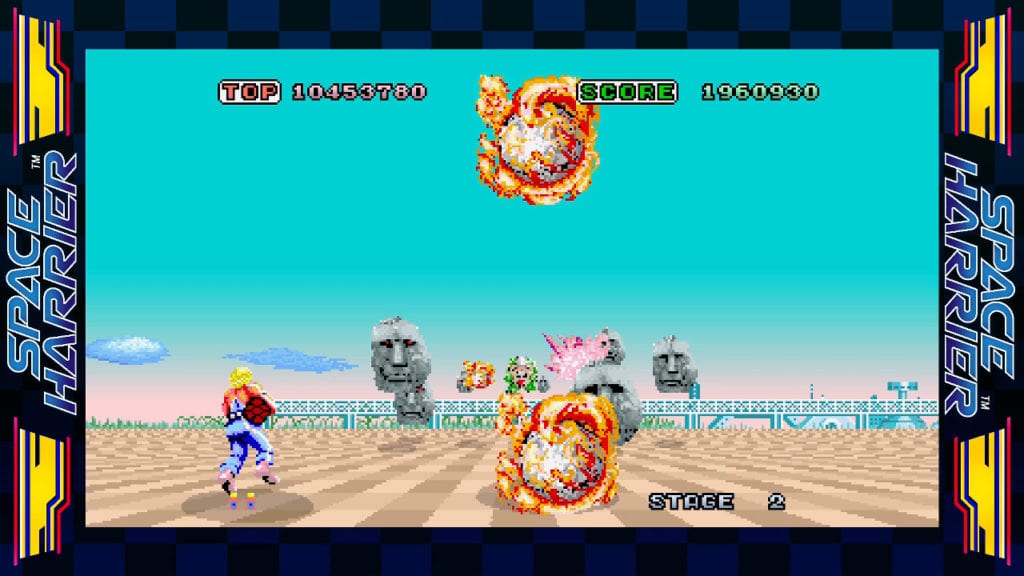
If this all sounds familiar to you, then congratulations: This means you probably played 3D Classics Space Harrier on the Nintendo 3DS. This release matches up very closely to that one, but there are some differences to be aware of.
For starters, those 3D Classics based on SEGA’s arcade games would often try to recreate the arcade experience as closely as possible. This ranged from having a “moving cabinet” to the sound the buttons make when pressed, so you can have that satisfying “click” sound. Sadly, those flourishes are not included here.
Then, of course, there’s the whole 3D thing. Ever since playing Star Fox 64 3D, I wanted to see Space Harrier get the same treatment. I was thinking of a new installment, but M2’s more literal take was nevertheless a sight to behold.
Naturally, you don’t get that in the Switch version. What you do get, however, are an interesting pair of optional additions.
First is what’s called the “Komainu Barrier Attack,” wherein a pair of Komainu flank your left and right sides, generating a special barrier that shields you from most obstacles — trees, rocks, columns, stuff like that, but not enemies or their projectiles. Allow them to take a hit, though, and you’re on your own. Without this barrier, it probably would have taken me at least twice as many as however many credits I used to get through.
The other is “Joystick Mode.” Despite the character flying around with the aid of a gun, the original Space Harrier arcade game utilized a full-blown flight stick to control Harrier’s movements (and in some cases, a machine with a full cockpit). M2 attempts to recreate some of that feel here by allowing you to take a single Joy-Con controller and use it to simulate the movement of the flight stick.
I’m not sure how well it works in practice, however, as my Joy-Con suffers from some serious drift (and yes, I know all the different tricks — they either haven’t helped, or I haven’t been able to purchase the equipment to implement them). Whether that was somehow affecting Harrier’s flight, or if it was something else, I’m really not sure. There were moments when it worked nicely and felt good, yet difficult to imagine clearing the game with, and other times when I struggled to get Harrier to move where I needed. Hopefully, it’s just the Joy-Con’s shoddy craftsmanship that’s to blame.
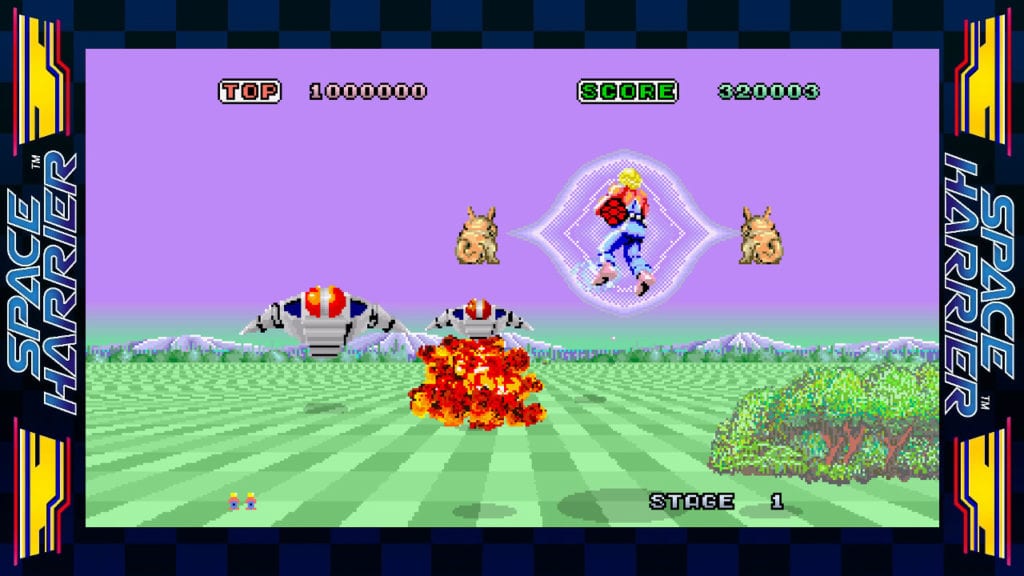
Welcome to the Summary Zone!
With a release like this, you hope to end up with the definitive version of a game. However, while I think that nod still goes to the 3D Classics version, the SEGA Ages port is by no means anything to sneeze at. Within the constraints of the hardware (read: no 3D), this is just about as good as it gets, and this piece of SEGA history is one any fan should be proud to have on their Switch.
Pros:
- Komainu Barrier Attack gives a little more of an edge without making the game too easy.
- Options, options, options.
- Stunning visuals – in a retro sense, of course.
Cons:
- No arcade visual and sound effects like the 3DS version.
- No 3D visuals (not that I was expecting any)
